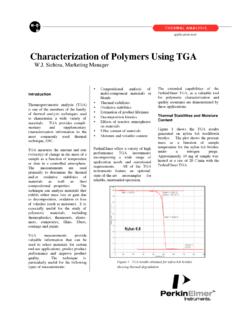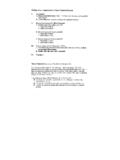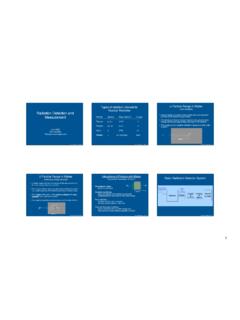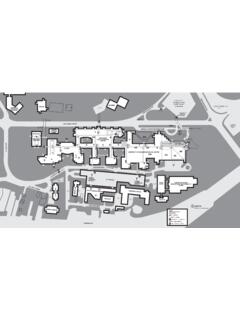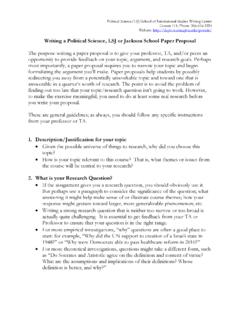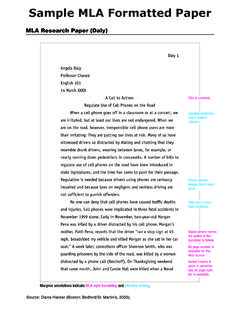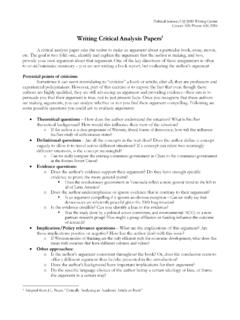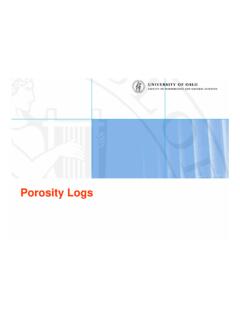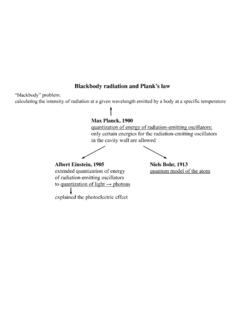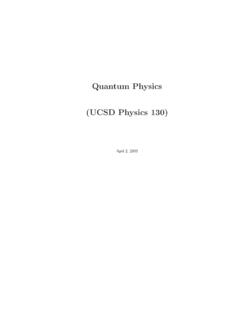Transcription of Radiation Detection and Measurement
1 Rad. Detect & Measure, 2008 (TKL) Radiation Detection andMeasurementJune 2008 Tom Detect & Measure, 2008 (TKL)Types of Radiation relevant toNuclear MedicineParticleSymbolMass (MeV/c2) ChargeElectrone-, ! -1 Positrone+, !+ +1 Alpha" 3700 +2 Photon# no rest mass noneRad. Detect & Measure, 2008 (TKL) Loses energy in a more or less continuous slowing downprocess as it travels through matter. The distance it travels (range) depend only upon its initialenergy and its average energy loss rate in the medium. The range for an " particle emitted in tissue is on the orderof m s." Particle Range in Mattermono-energetic- - - - - - - - - - - - - - - - - - -+ + + + + + + + + + + + + + + + + m s"Rad. Detect & Measure, 2008 (TKL) ! particle ranges vary from one electron to the next, even for !s ofthe same energy in the same material.
2 This is due to different types of scattering events the ! encounters( , scattering events, bremsstrahlung-producing collisions, etc.). The ! range is often given as the maximum distance the mostenergetic ! can travel in the medium. The range for ! particles emitted in tissue is on the order of mm s.! Particle Range in Mattercontinuous energy spectrummm s-! Rad. Detect & Measure, 2008 (TKL)Interactions of Photons with MatterExponential Penetration: N=N0e-$xPhotoelectric effectphoton is absorbedCompton scatteringpart of the energy of the photon is absorbedscattered photon continues on with lower energyPair productionpositron-electron pair is createdrequires photons above MeVCoherent (Rayleigh) scatteringphoton deflected with very little energy lossonly significant at low photon energies (<50 keV)$cm sNN0xRad. Detect & Measure, 2008 (TKL)Basic Radiation Detector SystemPulseorCurrentstoredto diskincoming radiationAnalog-to-digitalAmplify&condit ionRad.
3 Detect & Measure, 2008 (TKL)Basic Radiation Detector SystemsWhat do you want to know about the Radiation ?Energy?Position (where did it come from)?How many / how much?Important properties of Radiation detectors(depends on application)Energy resolutionSpatial resolutionSensitivityCounting SpeedRad. Detect & Measure, 2008 (TKL)Pulse Mode versus Current Mode Pulse mode Detect individual photons Required for NM imaging applications Current mode Measures average rates of photon flux Avoids dead-time lossesRad. Detect & Measure, 2008 (TKL)Interaction Rate and Dead-timeparalyzablenon-paralyzableFrom: The Essential Physics of Medical Imaging (Bushberg, et al)True rateMeasured ratetimedeadtime= recorded eventsRad. Detect & Measure, 2008 (TKL)Types of Radiation Detectorsdetection modes / functionality Counters Number of interactions Pulse mode Spectrometers Number and energy of interactions Pulse mode Dosimeters Net amount of energy deposited Current mode Imaging Systems CT = current mode NM = pulse modeRad.
4 Detect & Measure, 2008 (TKL)Types of Radiation Detectorsphysical composition Gas-filled detectors Solid-state (semiconductor) detectors Organic scintillators (liquid & plastic) Inorganic scintillatorsscintillators operate with aphoto-sensor( another detector)Rad. Detect & Measure, 2008 (TKL)Gas-filled DetectorsIonizing event in airrequires about 34 eVFrom: Physics in Nuclear Medicine (Sorenson and Phelps)Rad. Detect & Measure, 2008 (TKL)Gas-filled detectors(operates in three ranges)Geiger-Muller countersProportional countersIonization chambers Radiation survey meters Dosimeters (dose calibrator)From: Radiation Detection and Measurement (Knoll, GF)Rad. Detect & Measure, 2008 (TKL)Ionization ChambersFrom: Physics in Nuclear Medicine (Sorenson and Phelps)ATOMLAB 200 Dose CalibratorNo amplificationNo dead-timeSignal = liberated chargeSettings for different isotopesCalibrationsIonizationchamber regionRad.
5 Detect & Measure, 2008 (TKL)Geiger-Muller countersFrom: Physics in Nuclear Medicine (Sorenson and Phelps)No energy infoLong dead-timeThin window probeRad. Detect & Measure, 2008 (TKL)Semiconductor Detectors Works on same principle as gas-filled detectors( , production of electron-hole pairs insemiconductor material) Only ~3 eV required for ionization (~34 eV, air) Usually needs to be cooled (thermal noise) Usually requires very high purity materials orintroduction of compensating impurities thatdonate electrons to fill electron traps caused byother impuritiesRad. Detect & Measure, 2008 (TKL)Semiconductor Detectors CdZnTe detectors - can operate atroom temperatureRad. Detect & Measure, 2008 (TKL)Organic Liquid Scintillators(liquid scintillator cocktail) Organic solvent - must dissolve scintillator material andradioactive sample Primary scintillator (p-terphenyl and PPO) Secondary solute (wave-shifter) Additives ( , solubilizers) Effective for measuring beta particles ( , H-3, C-14).
6 Rad. Detect & Measure, 2008 (TKL)Inorganic Scintillators(physical characteristics)Absorption of Radiation lifts electrons from valence toconduction bandImpurities (activators) create energy levels within theband gap permitting visible light scintillationsRad. Detect & Measure, 2008 (TKL)Inorganic Scintillators(physical characteristics)NaI(Tl)BGOLSO(Ce)GSO(Ce) Density (gm/cm3) Number51756659 AttenuationCoefficient(@ 511 keV, cm-1) Output(photons/Mev)40K~8K~30K~20 KDecay Time230 ns300 ns12 ns60 ns40 nsWavelength410 nm480 nm420 nm430 nmIndex of e sn on on oRuggedn oy e sy e sn osensitivityenergy & spatial speedphoto-sensor matchingmanufacturing / costrelevant detectorpropertyRad. Detect & Measure, 2008 (TKL)Photomultiplier Tube (PMT)From: Physics in Nuclear Medicine (Sorenson and Phelps)photo-sensor needed with scintillatorsRad. Detect & Measure, 2008 (TKL)Sample Spectroscopy SystemHardwareFrom: The Essential Physics of Medical Imaging (Bushberg, et al)incoming high-energy gammarayconverted to1000s of visiblephotons~20%converted toelectronselectron multiplicationbecomes electricsignallarger current orvoltage|more electrons|more scintillationphotons|higher gammaenergy(statisticaluncertainties!)
7 Rad. Detect & Measure, 2008 (TKL)Interactions of Photons with + with characteristicx-ray scattered photon fromlead x-ray from leadshieldFrom: The Essential Physics of Medical Imaging (Bushberg, et al)Rad. Detect & Measure, 2008 (TKL)Sample Spectroscopy SystemOutputFrom: Physics in Nuclear Medicine (Sorenson and Phelps)From: The Essential Physics of Medical Imaging (Bushberg, et al)counting modeIdeal Energy SpectrumRad. Detect & Measure, 2008 (TKL)Energy ResolutionFrom: Physics in Nuclear Medicine (Sorenson and Phelps)Realistic Energy SpectrumRad. Detect & Measure, 2008 (TKL)Sample Spectrum (Cs-137) x-ray x-raysDetection efficiency(32 keV vs. 662 keV)From: The Essential Physics of Medical Imaging (Bushberg, et al)Rad. Detect & Measure, 2008 (TKL)Sample Spectrum (Tc-99m) withiodine K-shell of lead x-rays from shieldFrom: The Essential Physics of Medical Imaging (Bushberg, et al)Rad.
8 Detect & Measure, 2008 (TKL)Sample Spectrum (In-111)sourcedetectorFrom: Physics in Nuclear Medicine (Sorenson and Phelps)Rad. Detect & Measure, 2008 (TKL)Effects of Pulse PileupFrom: Physics in Nuclear Medicine (Sorenson and Phelps)Rad. Detect & Measure, 2008 (TKL)Calibrations Energy calibration (imaging systems/spectroscopy) Adjust energy windows around a known photopeak Often done with long-lives isotopes for convenience Cs-137: E#= 662 keV (close to PET 511 keV), T1/2=30yrCo-57: E#= 122 keV (close to Tc99m 140 keV ), T1/2=272d Dose calibration (dose calibrator) Measure activity of know reference samples ( , Cs-137 and Co-57) Linearity measured by repeated measurements of adecaying source ( , Tc-99m)Rad. Detect & Measure, 2008 (TKL)Raphex QuestionD58. The window setting used for Tc-99m is set with the center at 140 keV with a width of +/-14 keV , 20%.
9 The reason for this is: A. The energy spread is a consequence of the statistical broadening when amplifying the initial energy deposition event in the NaI(Tl) crystal. B. The 140 keV gamma ray emission of Tc-99m is not truly monoenergetic but the center of a spectrum of emissions. C. The higher and lower Gaussian tails are a consequence of compton scattering within the patient. D. The result of additional scattered photons generated in the collimator. E. A consequence of patient motion during scanning. Rad. Detect & Measure, 2008 (TKL)Raphex AnswerD58. The window setting used for Tc-99m is set with the center at 140 keV with a width of +/-14 keV , 20%. The reason for this is: A . Photons, which impinge upon the crystal, lose energy by compton scattering and the photoelectric effect. Both processes convert the gamma ray energy into electron energy.
10 On average approximately one electron hole pair is produced per 30 eV of gamma ray energy deposited in the crystal. These electrons result in the release of visible light when trapped in the crystal. These light quanta are collected and amplified by photomultiplier tubes. The statistical fluctuation in the number of light quanta collected and their amplification is what causes the spread in the detected energy peak, even when most of the Tc-99m photons deposit exactly 140 keV in the NaI(Tl) crystal. Rad. Detect & Measure, 2008 (TKL)Counting StatisticsRad. Detect & Measure, 2008 (TKL)Sources of Error Systematic errors Consistently get the same error Random errors Radiation emission and Detection arerandom processes Blunder operator errorRad. Detect & Measure, 2008 (TKL)Measures of Central Tendency Mean Average value Median Middlemost Measurement (or value) Less affected by outliersExample: 8, 14, 5, 9, 12 Mean = = 9 Rad.
